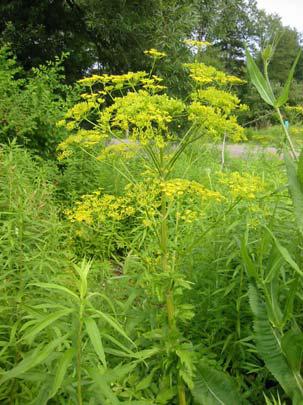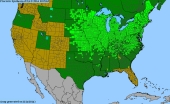
 4
4




Argue for your limitations and they are yours forever.
 5
5




 2
2




Sonja Draven wrote:Definitely English ivy for me too. It is pretty but so invasive here and damages everything. (As has been said.)
And you have to burn it in the winter because it won't die otherwise and it just spreads. (I am actually watching some burn as i type this for that reason.) Pulling it isn't enough. It roots multiple places, breaks off, etc.
Blackberry and dandelion can be tough but I can and do eat and use them. (I can understand why others don't feel as I do.)
 4
4




Mandrake...takes on and holds the influence
of the devil more than other herbs because of its similarity
to a human. Whence, also, a person’s desires, whether good
or evil, are stirred up through it...
-Hildegard of Bingen, Physica
 5
5




 3
3




Today Hank talks with Dr. Cara Nelson about invasive plants that use toxic chemicals and rapid reproduction to outcompete native plants, and Jessi brings some adorable invasive birds. Dr. Nelson is a professor of Restoration Ecology at the W.A. Franke College of Forestry and Conservation, University of Montana.
"Where will you drive your own picket stake? Where will you choose to make your stand? Give me a threshold, a specific point at which you will finally stop running, at which you will finally fight back." (Derrick Jensen)
 6
6




![Filename: 79A970A9-F487-4EFA-B1A2-B006A494C951.png
Description: range of Heracleum mantegazzianum in North America according to the online BONAP plant atlas [Thumbnail for 79A970A9-F487-4EFA-B1A2-B006A494C951.png]](/t/98062/a/73939/thumb-79A970A9-F487-4EFA-B1A2-B006A494C951.png)
Mandrake...takes on and holds the influence
of the devil more than other herbs because of its similarity
to a human. Whence, also, a person’s desires, whether good
or evil, are stirred up through it...
-Hildegard of Bingen, Physica
 5
5





 3
3




A human being should be able to change a diaper, plan an invasion, butcher a hog, conn a ship, design a building, write a sonnet, balance accounts, build a wall, set a bone, comfort the dying, take orders, give orders, cooperate, act alone, solve equations, analyze a new problem, pitch manure, program a computer, cook a tasty meal, fight efficiently, die gallantly. Specialization is for insects.
-Robert A. Heinlein
 2
2




Rin Corbin wrote:Puncture vine. It’s where the Romans got the idea for caltrops, it goes through bike tires, and the seeds last up to 6 years in the ground. Mulch with cardboard (not the best, but solid enough) covered with 10+cm of normal mulch seems to keep it from sprouting. I’ve heard rumors of lawn rollers covered with yoga mats, but haven’t tried that yet.
 5
5




It's time to get positive about negative thinking  -Art Donnelly
-Art Donnelly
 3
3




 2
2




 2
2




Brian Vraken wrote:
Wild Parsnip (Pastinaca sativa) is a big problem here. It's an invasive, and a relative of the feared Giant Hogweed. It grows up to 6' tall, and the sap of the plant will cause extreme photosensitivity in skin - if the sap is exposed to UV rays while on your skin, you get more or less immediate blisters. When they leave, you often have a dark spot on your skin in that area for a couple of years, and lifelong photosensitivity in that area. If the sap gets into your eyes, it can cause blindness - this has happened to both children and adults alike - a lot of people will use a string trimmer on them without knowing the danger of the spray that gets generated.
The root is edible apparently, but still has a low concentration of the irritant that is in the sap. For some people, it's fine, others get mouth blisters. I haven't tried it to see which group I fall into.
It will grow anywhere with adequate sun. It's in all the roadside ditches, field boundaries and wherever else around here. It's all over my property, and it means that I need to strictly control the areas my children go in the summer.
The frustrating thing is that the province has declared it a noxious weed, and landowners are technically required to control it on their property or face fines. But the municipalities don't do anything about it on all the roadside ditches and common areas, so the seeds just blow in every year thick and heavy.
We live in a rural area, and if one of my kids was to have their bike go off the road into the ditch, they would be covered in the stuff.
There's few plants I would ever advocate spraying for, but this is one.
You do not have to be good.You do not have to walk on your knees For a hundred miles through the desert, repenting.You only have to let the soft animal of your body
love what it loves. -Mary Oliver
 2
2




Wayne Mackenzie wrote:Pig weed.
It makes my face swell when working around it’s blooms.
Mandrake...takes on and holds the influence
of the devil more than other herbs because of its similarity
to a human. Whence, also, a person’s desires, whether good
or evil, are stirred up through it...
-Hildegard of Bingen, Physica
 5
5




No rain, no rainbow.
 4
4




Ryan M Miller wrote:
Have you had these same reactions when handling cultivated Amaranth?
By the way, the human reaction to poison ivy (Toxicodendron radicans) is also actually an allergic reaction.
 4
4




Nails are sold by the pound, that makes sense.
Soluna Garden Farm -- Flower CSA -- plants, and cut flowers at our farm.
 3
3




out in the garden

 3
3




—
Sim
 2
2




Live your own dream, let nothing stop you.
 2
2




 2
2




Mandrake...takes on and holds the influence
of the devil more than other herbs because of its similarity
to a human. Whence, also, a person’s desires, whether good
or evil, are stirred up through it...
-Hildegard of Bingen, Physica
 2
2




Ryan M Miller wrote:So that's the white-flower morning glory that keeps popping up in my neighbors' yards. I've had to remove bindweed (Convolvulus arvensis) from landscaping before. The plant seems to be far more aggressive than even periwinkle vines (Vinca minor).
Live your own dream, let nothing stop you.




Su Ba wrote:Hands down it is Bermuda grass. It aggressively spreads underground. Impossible to completely dig out except for repeated removal over years of effort. It's the only weed I haven't been able to conquer on my farm. I've chopped it, dug it out, smothered it for a year, flamed it, and used several organic weedkillers. Outside of ruining my garden soil, I can't easily control it. I have had to resort to digging down 8 inches to remove the stolon of every shoot I see coming up. That's quite an impossible task when you're growing on 4 acres of old pasture area. It may possibly take the rest of my life to clear my growing beds.
Author at https://succulentcity.com
 3
3




 3
3




 3
3





 5
5




Some places need to be wild




Lovin the country life 🐔








Eric Hanson wrote:
The most difficult weed for me though is Johnson Grass. The stuff is incredibly resilient! It grows by rhizomes and by seed, so it spreads easily. I am pretty sure that it is a C4 plant as it grows very fast, thrives in drought. And I really mean it THRIVES during drought periods. Every other grass will turn yellow and then brown, but Johnson Grass is green and lush. Mowing slows it down, but I have no idea how to get rid of the stuff.




 1
1




“We can complain because rose bushes have thorns, or rejoice because thorn bushes have roses.” — Abraham Lincoln
 1
1




 1
1



















 2
2




Visit Redhawk's soil series: https://permies.com/wiki/redhawk-soil
How permies.com works: https://permies.com/wiki/34193/permies-works-links-threads

|
Barry's not gonna like this. Barry's not gonna like this one bit. What is Barry's deal with tiny ads?
Learn Permaculture through a little hard work
https://wheaton-labs.com/bootcamp
|








